 Nations: Mania: Currency
Nations: Mania: Currency Nations: Mania: Currency
Nations: Mania: Currency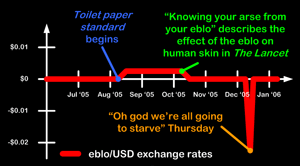 The currency of the Republic of Mania is the eblo, this being an Esperanto word meaning prospect or possibility.
The currency of the Republic of Mania is the eblo, this being an Esperanto word meaning prospect or possibility.
Sadly, since the 8th December 2005 - or Oh god we're all going to starve Thursday, as it has become known - those prospects have seemed limited. Events were precipitated by Alan Greenspan, outgoing chief of the US Federal Reserve and internationally respected economist. When asked about the eblo as a medium of investment, he said:
If necessary, bite off your own testicles to sell them.
International money markets, always somewhat negative in their view of the Manic economy, took Greenspan's words as a bad sign, and the eblo briefly dipped from its previous exchange rate of 1 eblo to 0 US dollars to an exchange rate of 1 eblo to -0.03 US dollars, which suggested that there were dealers prepared to give you money simply to take the currency away. A few had to be suspended by the Security and Exchange Commission when, in order to avoid holding negatively valued bills, they resorted to illegally eating the money.
 Alan Greenspan is asked
Alan Greenspan is asked
if the eblo might replace the
dollar as world currencyEconomists argue that a number of factors have contributed to the problem of eblo inflation, not the least of which being that rather than distribute the currency through financial institutions, the Central Bank of Mania simply makes digital masters publically available and encourages people to forge as many as they need. Though this succeeded in its aim of 'reducing distribution costs', it is nevertheless held by some to represent slack monetary control.
When the value of the eblo fell below that of an equivalently sized sheet of toilet paper, the currency briefly stabilised as citizens started buying notes to use as toilet paper. This became known as the toilet-paper standard, and briefly eliminated further inflation by giving the eblo an objective, if rather low, value. In principle, it became possible to trade huge quantities of eblo for actual goods, such as apples or small pieces of chewing gum. However, this brief economic miracle was ended by the discovery that the ink with which the eblo was printed caused skin irritation, and even piles, after which people went back to using actual toilet paper. The Manic government briefly considered switching to toilet paper as the new currency, but in the end this idea was rejected as being silly.

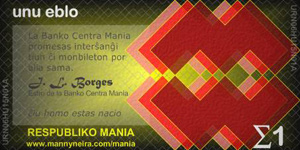 There are seven eblo notes, tinted according to the colours of the rainbow (cf. Mania's anthem), and in denominations of E1, E2, E5, E10, E20, E50, and E100. Aside from the tint and the denomination, the reverse of each note is the same, and bears the message La Banko Centra Mania promesas intersxangi tiun cxi monbileton por alia sama, or The Central Bank of Mania promises to exchange this note for another one exactly the same, and carries the signature of the head of the bank, Jorge Luis Borges (cf. Borges's role as Second Minister of Mania in government).
There are seven eblo notes, tinted according to the colours of the rainbow (cf. Mania's anthem), and in denominations of E1, E2, E5, E10, E20, E50, and E100. Aside from the tint and the denomination, the reverse of each note is the same, and bears the message La Banko Centra Mania promesas intersxangi tiun cxi monbileton por alia sama, or The Central Bank of Mania promises to exchange this note for another one exactly the same, and carries the signature of the head of the bank, Jorge Luis Borges (cf. Borges's role as Second Minister of Mania in government).
The front of the notes bear a series of designs celebrating micronationality. Each shows the territory of a micronation, along with one of its symbols: a different symbol in each case.
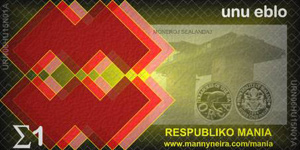 1 eblo note: Sealand with coinsDenomination: 1 eblo
1 eblo note: Sealand with coinsDenomination: 1 eblo
Colour: Red
Micronation: The Principality of Sealand
Symbol of nationality: Coins
Territory shown: Roughs Tower, a former British sea-fort 10km off the coast of southern England, occupied and declared independent by Roy Bates in 1967.
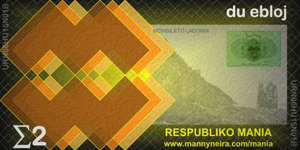 2 eblo note: Ladonia with banknoteDenomination: 2 eblo
2 eblo note: Ladonia with banknoteDenomination: 2 eblo
Colour: Orange
Micronation: The Remony of Ladonia
Symbol of nationality: Banknote
Territory shown: A view of the square kilometre of coastal land seceded from Sweden by artist Lars Vilks. His sculpture Nimis is visible in the distance.
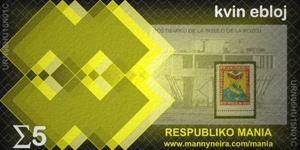 5 eblo note: Rose Island with stampDenomination: 5 eblo
5 eblo note: Rose Island with stampDenomination: 5 eblo
Colour: Yellow
Micronation: The Republic of Rose Island
Symbol of nationality: Stamp
Territory shown: A 1968 photograph of the purpose built platform located in the Adriatic 10km off the coast of Rimini, invaded, occupied, and finally blown up by the Italian state.
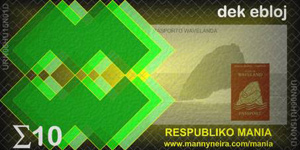 10 eblo note: Waveland with passportDenomination: 10 eblo
10 eblo note: Waveland with passportDenomination: 10 eblo
Colour: Green
Micronation: The Global State of Waveland
Symbol of nationality: Passport
Territory shown: The tiny 30m wide island of Rockall in the North Sea, occupied and declared independent by the environmental campaign group Greenpeace.
 20 eblo note: Freedonia with coat of armsDenomination: 20 eblo
20 eblo note: Freedonia with coat of armsDenomination: 20 eblo
Colour: Blue
Micronation: The Principality of Freedonia
Symbol of nationality: Coat of arms
Territory shown: An artist's impression of the artificial floating islands which the Freedonians originally intended to build, though they now concentrate on securing territory by agreement with an existing state.
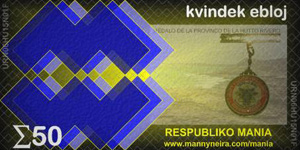 50 eblo note: Hutt River Province with medalDenomination: 50 eblo
50 eblo note: Hutt River Province with medalDenomination: 50 eblo
Colour: Indigo
Micronation: The Hutt River Province
Symbol of nationality: Medal
Territory shown: A photograph of part of the coastal land seceded from Australia by farmer Leonard George Casley.
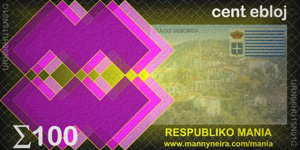 100 eblo note: Seborga with flagDenomination: 100 eblo
100 eblo note: Seborga with flagDenomination: 100 eblo
Colour: Violet
Micronation: The principality of Seborga
Symbol of nationality: Flag
Territory shown: A photograph of the town of Seboraga, claimed by its people to have remained independent despite the formation of the Italian state around it.

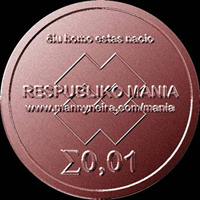 The front of an ebletoThe currency also includes seven coins, valued in hundredths of an eblo. These are known as ebleto, which literally means little eblo. The coins are minted from a coloured metal alloy and, like the notes described above, their colours are taken from the colours of the rainbow. Their denominations are E0,01, E0,02, E0,05, E0,10, E0,20, E0,50 and E1 (British readers should not the use of the comma in place of the 'decimal point' in Manic numbering).
The front of an ebletoThe currency also includes seven coins, valued in hundredths of an eblo. These are known as ebleto, which literally means little eblo. The coins are minted from a coloured metal alloy and, like the notes described above, their colours are taken from the colours of the rainbow. Their denominations are E0,01, E0,02, E0,05, E0,10, E0,20, E0,50 and E1 (British readers should not the use of the comma in place of the 'decimal point' in Manic numbering).
The front of each coin bears the denomination, the name of the republic, and the national motto cxiu homo estas nacio, or every human is a nation.
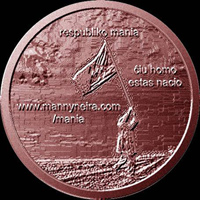 The back of an ebletoThe reverse of each coin is the same, showing a relief image of a man bearing a Manic flag, and repeating the name of the republic and the national motto.
The back of an ebletoThe reverse of each coin is the same, showing a relief image of a man bearing a Manic flag, and repeating the name of the republic and the national motto.